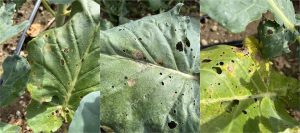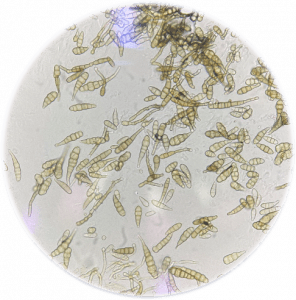Alternaria Leaf Blight and Head Rot of Brassicas: Identification and Management
Author: Roy L. Davis II
roy.davis@uconn.edu
Reviewers: Charles Krasnow, UConn Extension and Christine Smart, Cornell University
Publication EXT155 | September 2025
Introduction
Alternaria leaf blight and head rot (ABHR), also known as Alternaria leaf spot, is an economically important fungal disease of brassicas, such as broccoli, cabbage, kale, and cauliflower, among others. In Connecticut, this disease is primarily caused by Alternaria brassicicola, though both A. brassicae and A. alternata have been identified as pathogenic in the state. Though not identified in Connecticut, A. japonica is can also cause ABHR, though it is currently on has been identified in California, Georgia, and South Carolina.
This factsheet focuses on identification and management of Alternaria spp. affecting brassica production.
Symptoms
Initial symptoms of Alternaria blight and head rot include small, black spots on the foliage of brassicas. As the disease progresses, the leaf spots grow into distinctive, larger target-shaped lesions surrounded by a yellow halo (Figure 1). Cracks or shot holes may form in the center of lesions.
Symptoms tend to appear on the oldest, lower leaves of before spreading further to other plant parts (Figure 2). Severe infections may lead to defoliation. Lesions may also form on the heads of brassicas crops, such as broccoli and Brussels sprouts, and on the curds of cauliflower.


These pathogens can survive between seasons by overwintering on crop debris left in fields. Alternaria species affecting brassicas may also form thick-walled resting spores in the soil, to overwinter and survive until a viable host is available. Infected seeds allow the pathogen to survive between growing seasons, either on the seeds surface, or within the seed. Infestation of seeds may negatively impact germination.
Dispersal and Sources of Inoculum

Sources of primary inoculum include infected seeds or seedlings, crop debris, and potentially, weeds. Asexual Alternaria spores, known as conidia (Figure 3), are primarily dispersed by wind, and by splashing from rain events, or from overhead watering.
Conidia are typically produced at temperatures between 68 to 86 °F under conditions of high relative humidity (>87%). Cooler temperatures (55 to 75 °F) and prolonged periods of leaf wetness are conducive to infection and development of symptoms.
As the season progresses, symptomatic plants can serve as a secondary source of inoculum. Secondary spread of inoculum, through wind and splashing, can continue to spread conidia between plants within a field. Seeds and infected seedlings serve as a source of long-range distribution of inoculum.
Weeds
Weeds present either within fields, or along the margins of fields, can potentially serve as reservoirs for Alternaria spores and sources of primary or secondary inoculum.
In Connecticut, A. alternata has been identified on weeds redroot pigweed (Amaranthus retroflexus) and white goosefoot (Chenopodium album). In other states, such as New York, Alternaria brassicicola has been identified on weeds such as field pennycress (Thlaspi arvense), which is in the brassica family.
Brassica weeds present in Connecticut, such as garlic mustard (Allaria petiolata) or wild mustard (Brassica kaber), may also serve as potential wild hosts of Alternaria species that cause ABHR.
Occasional scouting to identify ABRH-like symptoms and implementing management is necessary to reduce the potential spread of Alternaria spores from weeds to broccoli, cabbage, or other brassica crops.
Management
Cultural Control
A variety of cultural controls can be used in tandem, to potentially reduce the potential for disease. Scouting for symptoms of disease, and early management, are useful to best control ABHR in brassica fields.
- Plant cultivars that are tolerant to the disease;
- Purchase certified seeds or seedling transplants from vendors that test for ABHR;
- Remove infected leaves or plants from the field to reduce inoculum sources;
- Limit overhead watering and prolonged periods of leaf wetness;
- Three-year rotations are recommended to alternate non-brassica hosts to reduce the primary inoculum sources;
- Improve airflow by increasing spacing between rows;
- Manage weeds within the field and in field margins;
- Control insects that may transport inoculum within and between fields.
Chemical Control
Fungicides used to control ABHR are curative, meaning that that they are typically used after symptoms are identified, not to prevent them. Refer to labels for proper usage instructions.
Table 1. Fungicides listed for control of Alternaria species on brassica crops (refer to labels).
| FRAC Code | Active Ingredient | Product |
| 11 | Azoxystrobin | Quadris |
| M5 | Chlorothianol | Bravo Weather Stik |
| M1a | Copper octonate | Cueva |
| P5a | Reynoutria sachalinensis | Regalia Biofungicide |
| BM02a | Bacillus subtilis QST 713 | Serenade ASO Biofungicide |
| a Organic Materials Review Institute (OMRI) listed products | ||
Resources
Resources
Cobb, A. C. and Dillard, H. R. 1998. Thlaspi arvense, a New Host for Alternaria brassicicola. Plant Dis. Doi: 82:960. Doi: 10.1094/PDIS.1998.82.8.960B.
Davis II, R. L., Cerritos-Garcia, D. G., Martin, A. G., Fenton Jr., M. F., Patel, K., Nieto-Lopez, E., Saint-Preux, C., da Silva, M. B., Betaw, H., Hoepting, C., Rideout, S., Langston, D., Smart, C. D., Dutta, B., and Everhart, S. E. 2025. Determining the causal agent of Alternaria leaf blight and head rot affecting broccoli in the Eastern United States. Plant Dis. Doi: 10.1094/PDIS-01-25-0117-SR.
Hoidal, N. 2023. Alternaria leaf spot and head rot of brassica crops. Retrieved from: https://extension.umn.edu/disease-management/alternaria-leaf-blight#cultural-controls-3120012
Keinath, A. P., Toporek, S. M., DuBose, V. B., Zardus, S. H, and Ballew, J. B. 2021. First report of Alternaria japonica, a causal agent of black spot, on kale in South Carolina, U. S. A. Plant Dis. 105:2016. Doi: 10.1094/PDIS-01-21-0085-PDN.
Li, Y. 2025. Alternaria leaf spot of brassicas. Retrieved from: https://portal.ct.gov/-/media/caes/publications/alternaria-leaf-spot-of-brassicas-final.pdf?rev=41182c49686a4136bbba58e23ab4ede2&hash=82EAB6225DB595885CCB4C727326492E
Nieto-Lopez, E. H., Cerritos-Garcia, D. G., Koch Bach, R. A., Petkar, A., Smart, C. D., Hoepting, C., Langston, D., Rideout, S., Dutta, B., and Everhart, S. E. 2023. Fungicide sensitivity of fungi causing Alternaria leaf blight and head rot in cole crops in the Eastern United States. Plant Dis. 107:1310-1315. Doi: 10.1094/PDIS-06-22-1318-SC.
Ocamb, C. M. 2025. Broccoli (Brassica oleracea) – Alternaria diseases (black spot, gray leaf spot, pod spot).
Sudermann, M. Alternaria leaf spot of brassicas. https://www.vegetables.cornell.edu/pest-management/disease-factsheets/alternaria-leaf-spot-of-brassicas/
The information in this document is for educational purposes only. The recommendations contained are based on the best available knowledge at the time of publication. Any reference to commercial products, trade or brand names is for information only, and no endorsement or approval is intended. UConn Extension does not guarantee or warrant the standard of any product referenced or imply approval of the product to the exclusion of others which also may be available. The University of Connecticut, UConn Extension, College of Agriculture, Health and Natural Resources is an equal opportunity program provider and employer.